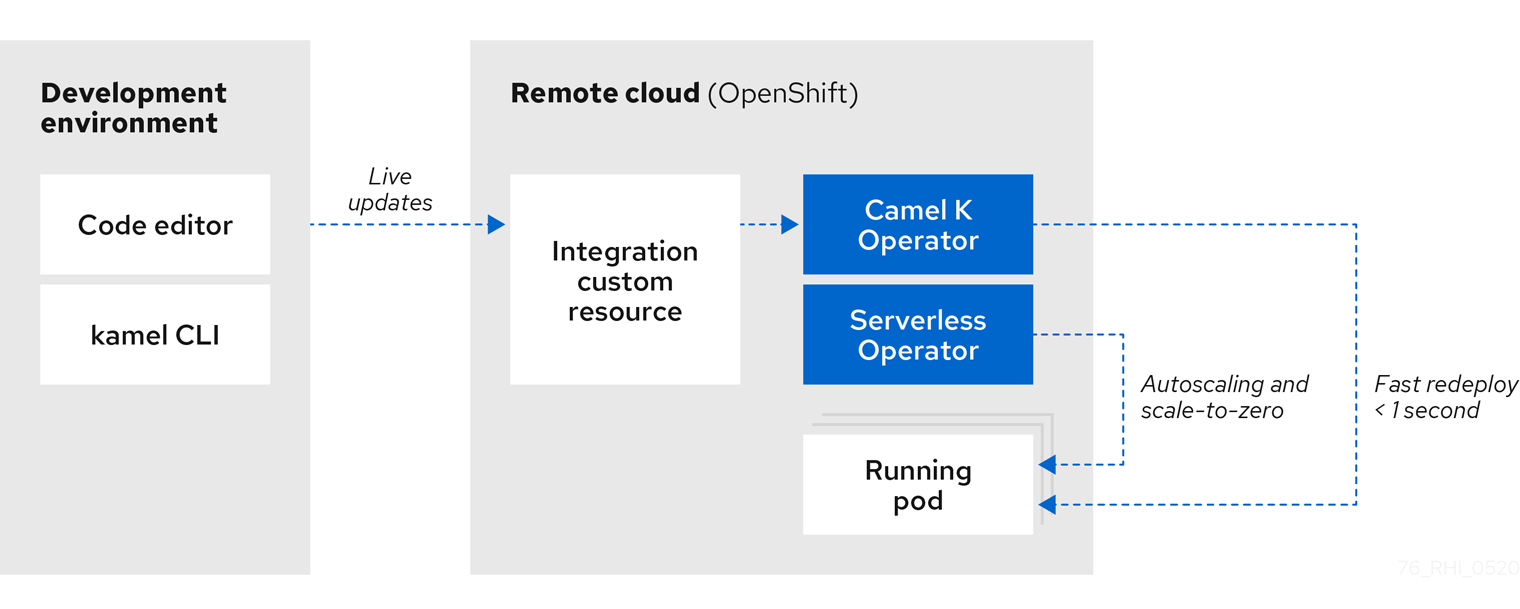此内容没有您所选择的语言版本。
Chapter 1. Introduction to Camel K
This chapter introduces the concepts, features, and cloud-native architecture provided by Red Hat Integration - Camel K:
1.1. Camel K overview
Red Hat Integration - Camel K is a lightweight integration framework built from Apache Camel K that runs natively in the cloud on OpenShift. Camel K is specifically designed for serverless and microservice architectures. You can use Camel K to instantly run your integration code written in Camel Domain Specific Language (DSL) directly on OpenShift. Camel K is a subproject of the Apache Camel open source community: https://github.com/apache/camel-k.
Camel K is implemented in the Go programming language and uses the Kubernetes Operator SDK to automatically deploy integrations in the cloud. For example, this includes automatically creating services and routes on OpenShift. This provides much faster turnaround times when deploying and redeploying integrations in the cloud, such as a few seconds or less instead of minutes.
The Camel K runtime provides significant performance optimizations. The Quarkus cloud-native Java framework is enabled by default to provide faster start up times, and lower memory and CPU footprints. When running Camel K in developer mode, you can make live updates to your integration DSL and view results instantly in the cloud on OpenShift, without waiting for your integration to redeploy.
Using Camel K with OpenShift Serverless and Knative Serving, containers are created only as needed and are autoscaled under load up and down to zero. This reduces cost by removing the overhead of server provisioning and maintenance and enables you to focus on application development instead.
Using Camel K with OpenShift Serverless and Knative Eventing, you can manage how components in your system communicate in an event-driven architecture for serverless applications. This provides flexibility and creates efficiencies through decoupled relationships between event producers and consumers using a publish-subscribe or event-streaming model.
Additional resources
1.2. Camel K features
The Camel K includes the following main platforms and features:
1.2.1. Platform and component versions
- OpenShift Container 4.6 or Platform 4.7
- OpenShift Serverless 1.16.0
- Quarkus 1.8 Java runtime
- Apache Camel K 1.4.0
- Apache Camel 3.10
- Apache Camel Quarkus 1.8
- OpenJDK 11
1.2.2. Camel K features
- Knative Serving for autoscaling and scale-to-zero
- Knative Eventing for event-driven architectures
- Performance optimizations using Quarkus runtime by default
- Camel integrations written in Java or YAML DSL
- Development tooling with Visual Studio Code
- Monitoring of integrations using Prometheus in OpenShift
- Quickstart tutorials
- Kamelet catalog of connectors to external systems such as AWS, Jira, and Salesforce
The following diagram shows a simplified view of the Camel K cloud-native architecture:
Additional resources
1.2.3. Kamelets
Kamelets hide the complexity of connecting to external systems behind a simple interface, which contains all the information needed to instantiate them, even for users who are not familiar with Camel.
Kamelets are implemented as custom resources that you can install on an OpenShift cluster and use in Camel K integrations. Kamelets are route templates that use Camel components designed to connect to external systems without requiring deep understanding of the component. Kamelets abstract the details of connecting to external systems. You can also combine Kamelets to create complex Camel integrations, just like using standard Camel components.
Additional resources
1.3. Camel K development tooling
The Camel K provides development tooling extensions for Visual Studio (VS) Code, Red Hat CodeReady WorkSpaces, and Eclipse Che. The Camel-based tooling extensions include features such as automatic completion of Camel DSL code, Camel K modeline configuration, and Camel K traits. While Didact tutorial tooling extensions provide automatic execution of Camel K quick start tutorial commands.
The following VS Code development tooling extensions are available:
VS Code Extension Pack for Apache Camel by Red Hat
- Tooling for Apache Camel K extension
- Language Support for Apache Camel extension
- Additional extensions for OpenShift, Java and more
- Didact Tutorial Tools for VS Code extension
For details on how to set up these VS Code extensions for Camel K, see Setting up your Camel K development environment.
Note: The Camel K VS Code extensions are community features.
Red Hat CodeReady Workspaces and Eclipse Che also provide these features using the vscode-camelk plug-in.
1.4. Camel K distributions
| Distribution | Description | Location |
|---|---|---|
| Operator image |
Container image for the Red Hat Integration - Camel K Operator: |
|
| Maven repository | Maven artifacts for Red Hat Integration - Camel K Red Hat provides Maven repositories that host the content we ship with our products. These repositories are available to download from the software downloads page. For Red Hat Integration - Camel K the following repositories are required:
Installation of Red Hat Integration - Camel K in offline mode is not supported in this release. | |
| Source code | Source code for Red Hat Integration - Camel K | |
| Quickstarts | Quick start tutorials:
|
You must have a subscription for Red Hat Integration and be logged into the Red Hat Customer Portal to access the Red Hat Integration - Camel K distributions.
